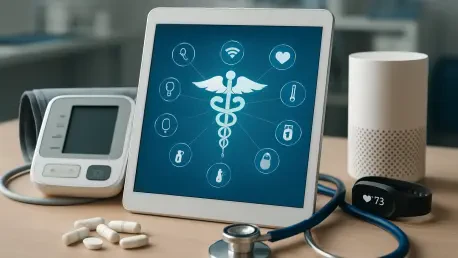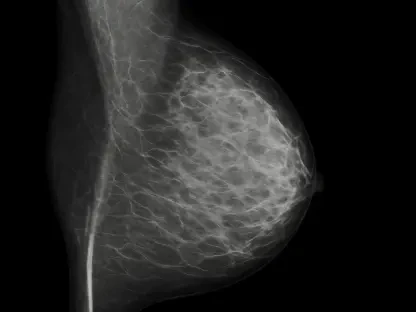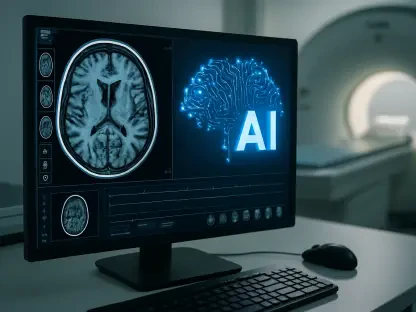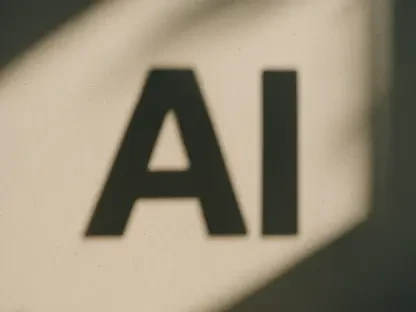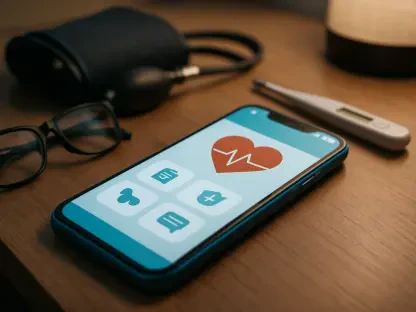Imagine a world where a patient with a chronic condition no longer needs to visit a hospital for routine checkups, as wearable devices continuously monitor vital signs and alert medical professionals to any anomalies in real-time. This scenario is rapidly becoming a reality with the rise of the Internet of Things (IoT) in healthcare, a technological revolution poised to redefine medical care over the next decade. Market projections indicate that the global IoT healthcare sector will skyrocket from its current valuation to an astonishing USD 594.5 billion by 2035, driven by a compound annual growth rate of 23.9%. This exponential growth reflects not just technological innovation but also a fundamental shift toward more accessible, efficient, and personalized medical solutions. As connected devices and smart systems integrate deeper into clinical and personal settings, the potential to enhance patient outcomes and streamline operations becomes undeniable, setting the stage for a transformative era in healthcare.
Emerging Technologies Driving Change
Wearable Sensors and Remote Monitoring
The integration of wearable sensors into healthcare is paving the way for unprecedented levels of patient oversight, particularly for those managing chronic illnesses or aging populations. These devices, ranging from smartwatches to implantable sensors, track vital metrics like heart rate, blood sugar, and activity levels, transmitting data directly to healthcare providers. This continuous stream of information enables early detection of potential issues, reducing the need for emergency interventions and hospital stays. Beyond individual care, such technology supports preventive health by encouraging users to adopt healthier lifestyles through real-time feedback. The ability to monitor patients remotely also alleviates pressure on medical facilities, allowing resources to be allocated more effectively. As these tools become more sophisticated, their role in fostering proactive healthcare will only expand, promising a future where medical crises are anticipated and mitigated before they escalate.
Another critical dimension of wearable tech lies in its synergy with remote patient monitoring (RPM) systems, which leverage cloud-based platforms to connect patients and providers across vast distances. This approach has proven invaluable in reducing hospital readmissions, especially for post-surgical or high-risk patients who can now receive follow-up care from the comfort of home. RPM not only enhances patient convenience but also cuts costs for healthcare systems by minimizing unnecessary visits. Additionally, it empowers individuals to take an active role in managing their health, as data-driven insights provide clarity on their conditions. With telehealth services increasingly relying on such systems, the barriers of geography and access are steadily diminishing. By 2035, the seamless integration of these technologies could redefine standard care models, making home-based monitoring a cornerstone of modern medicine.
AI and Predictive Analytics in IoT
Artificial Intelligence (AI) is revolutionizing how IoT data is utilized in healthcare by transforming raw information into actionable medical insights. Through predictive analytics, AI algorithms analyze patterns in patient data to forecast potential health risks, enabling early diagnosis and tailored treatment plans. This capability is particularly vital in managing complex conditions like diabetes or cardiovascular diseases, where timely intervention can be life-saving. Hospitals also benefit from AI-driven IoT systems that optimize workflows, such as predicting patient admission rates to better allocate staff and resources. The marriage of AI with connected devices ensures that healthcare delivery becomes not just reactive but anticipatory, addressing issues before they manifest into larger problems.
Beyond diagnostics, AI enhances the personalization of care through IoT ecosystems by adapting treatments to individual patient profiles based on continuous data inputs. This shift toward customized medicine means that therapies can be adjusted dynamically, improving efficacy and patient satisfaction. Furthermore, AI-powered tools assist in clinical decision-making by providing physicians with evidence-based recommendations, reducing the margin for human error. As these systems evolve, they will likely integrate with emerging consumer technologies, broadening their application beyond hospitals into everyday wellness management. The potential for AI to streamline operations while elevating care quality signals a profound change in how medical services are conceptualized, setting a foundation for a data-driven healthcare landscape by 2035.
Strategic Priorities for a Connected Future
Building Integrated IoT Ecosystems
Creating integrated IoT ecosystems stands as a pivotal goal for healthcare stakeholders aiming to maximize the technology’s impact over the coming years. These ecosystems involve seamless connectivity between devices, platforms, and healthcare providers to ensure that data flows effortlessly across systems. Such integration is essential for delivering cohesive care, as it allows disparate elements like wearable devices, hospital equipment, and telehealth tools to operate as a unified network. This interconnectedness not only improves patient monitoring but also enhances operational efficiency by automating routine tasks like inventory tracking and equipment maintenance. Industry leaders must prioritize interoperability to avoid fragmented systems that hinder progress, ensuring that the full spectrum of IoT benefits is realized.
Equally important is the focus on scalability within these ecosystems to accommodate the rapid growth projected through 2035. As more devices and users join the network, infrastructure must be robust enough to handle increased data volumes without compromising performance. Partnerships between tech companies, healthcare providers, and policymakers will be crucial in developing standardized protocols that facilitate widespread adoption. Additionally, investing in user-friendly interfaces ensures that both patients and professionals can navigate these systems with ease, fostering trust and engagement. By laying the groundwork for scalable, integrated IoT frameworks, the healthcare sector can prepare for a future where technology and care delivery are indistinguishable, driving better outcomes across diverse populations.
Addressing Cybersecurity and Data Privacy
As IoT adoption surges in healthcare, safeguarding sensitive patient data emerges as a non-negotiable priority to maintain trust and compliance with global regulations. The proliferation of connected devices increases vulnerability to cyberattacks, making robust cybersecurity measures essential to protect against breaches that could compromise personal health information. Hospitals and tech developers must implement advanced encryption, secure authentication protocols, and regular system audits to mitigate risks. Educating staff and patients on data security practices further strengthens defenses, ensuring that human error does not undermine technological safeguards. Without these protections, the transformative potential of IoT could be overshadowed by privacy concerns, stalling progress.
Another layer of this challenge involves balancing data accessibility with confidentiality, as healthcare systems rely on shared information for effective care coordination. Striking this balance requires innovative solutions like blockchain technology, which offers secure, decentralized data storage to prevent unauthorized access. Regulatory frameworks must also evolve to keep pace with technological advancements, providing clear guidelines on data usage and patient consent. Collaboration across sectors will be vital to establish best practices that prioritize both security and usability. By addressing these concerns head-on, the healthcare industry can build a resilient IoT infrastructure that supports innovation while upholding the highest standards of privacy, paving the way for sustained growth through 2035.
Reflecting on a Digital Healthcare Legacy
Looking back, the journey of IoT in healthcare over the past decade has revealed a profound shift toward a digitally empowered medical landscape. What began as niche applications of connected devices has evolved into a cornerstone of patient care and operational efficiency, reshaping how health services are delivered. The staggering market growth to nearly USD 600 billion by 2035 stands as a testament to the technology’s impact, driven by relentless innovation in wearables, AI analytics, and remote monitoring. Challenges like cybersecurity have been met with strategic solutions, ensuring that trust in these systems remains intact. As stakeholders navigate this transformation, the focus on integrated ecosystems and data-driven care has solidified IoT’s role in enhancing outcomes. Moving forward, the emphasis must shift to refining these technologies through global collaboration, investing in next-generation security measures, and advocating for policies that support equitable access. This legacy of innovation offers a blueprint for future advancements, urging continuous adaptation to meet evolving health needs.
